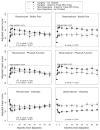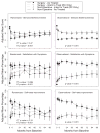Long-term outcomes of lumbar spinal stenosis: eight-year results of the Spine Patient Outcomes Research Trial (SPORT)
- PMID: 25569524
- PMCID: PMC4288009
- DOI: 10.1097/BRS.0000000000000731
Long-term outcomes of lumbar spinal stenosis: eight-year results of the Spine Patient Outcomes Research Trial (SPORT)
Abstract
Study design: Randomized trial with a concurrent observational cohort study.
Objective: To compare 8-year outcomes of surgery with nonoperative care for symptomatic lumbar spinal stenosis.
Summary of background data: Surgery for spinal stenosis has been shown to be more effective than nonoperative treatment during 4 years, but longer-term data are less clear.
Methods: Surgical candidates from 13 centers in 11 US states with at least 12 weeks of symptoms and confirmatory imaging were enrolled in a randomized cohort or observational cohort. Treatment was standard, decompressive laminectomy versus standard nonoperative care. Primary outcomes were SF-36 (MOS 36-Item Short-Form Health Survey) Bodily Pain and Physical Function scales and the modified Oswestry Disability Index assessed at 6 weeks, 3 months, 6 months, and yearly up to 8 years.
Results: Data were obtained for 55% of participants in the randomized group and 52% of participants in the observational group at the 8-year follow-up. Intent-to-treat analyses showed no differences between randomized cohorts; however, 70% of those randomized to surgery and 52% of those randomized to nonoperative had undergone surgery by 8 years. As-treated analyses in the randomized group showed that the early benefit for surgery out to 4 years converged over time, with no significant treatment effect of surgery seen in years 6 to 8 for any of the primary outcomes. In contrast, the observational group showed a stable advantage for surgery in all outcomes between years 5 and 8. Patients who were lost to follow-up were older, less well-educated, sicker, and had worse outcomes during the first 2 years in both surgical and nonoperative arms.
Conclusion: Patients with symptomatic spinal stenosis show diminishing benefits of surgery in as-treated analyses of the randomized group between 4 and 8 years, whereas outcomes in the observational group remained stable. Loss to follow-up of patients with worse early outcomes in both treatment groups could lead to overestimates of long-term outcomes but likely not bias treatment effect estimates.
Figures



Comment in
-
Specific Rehabilitation Protocol to Treat the Lumbar Stenosis.Spine (Phila Pa 1976). 2015 Jul 15;40(14):E854. doi: 10.1097/BRS.0000000000000979. Spine (Phila Pa 1976). 2015. PMID: 25955189 No abstract available.
References
-
- Atlas SJ, Deyo RA, Keller RB, et al. The Maine Lumbar Spine Study, Part III. 1-year outcomes of surgical and nonsurgical management of lumbar spinal stenosis. Spine. 1996;21:1787–94. discussion 94–5. - PubMed
-
- Atlas SJ, Keller RB, Robson D, et al. Surgical and nonsurgical management of lumbar spinal stenosis: four-year outcomes from the maine lumbar spine study. Spine. 2000;25:556–62. - PubMed
-
- Malmivaara A, Slatis P, Heliovaara M, et al. Surgical or nonoperative treatment for lumbar spinal stenosis?: a randomized controlled trial. Spine. 2007;32:1–8. - PubMed
Publication types
MeSH terms
Grants and funding
LinkOut - more resources
Full Text Sources
Other Literature Sources
Medical
Research Materials

